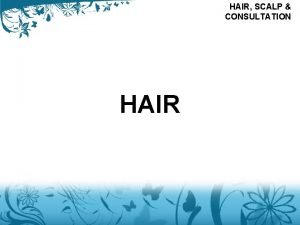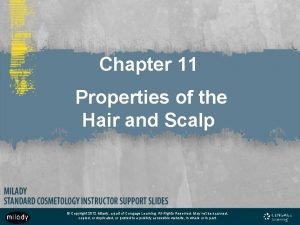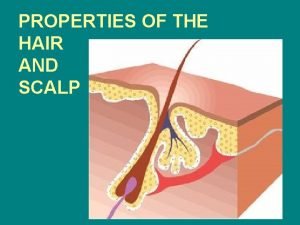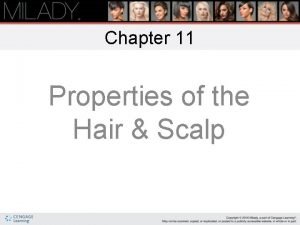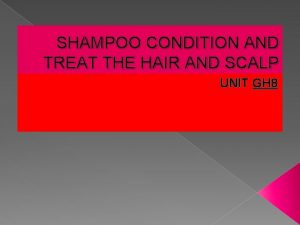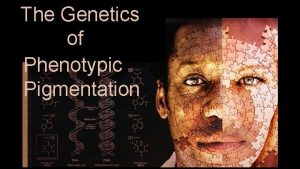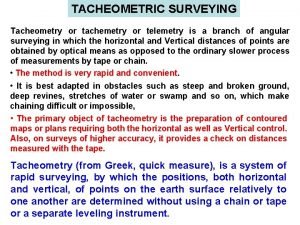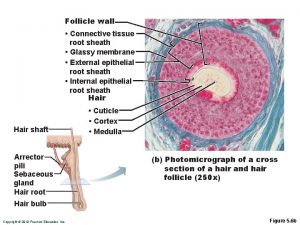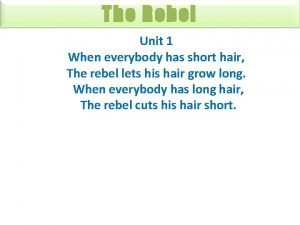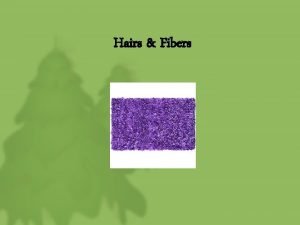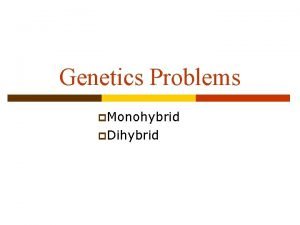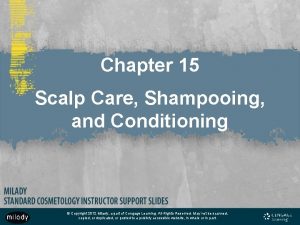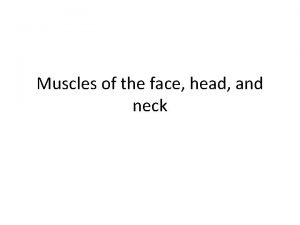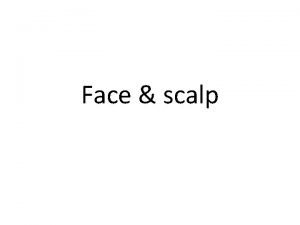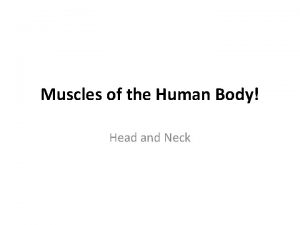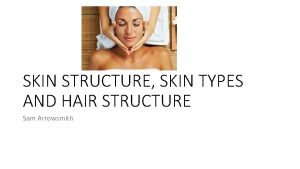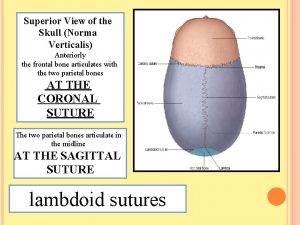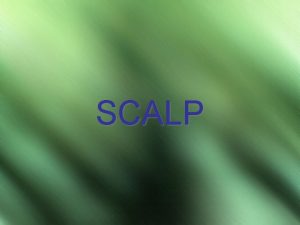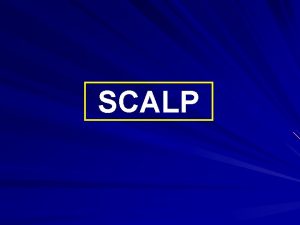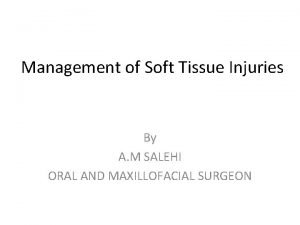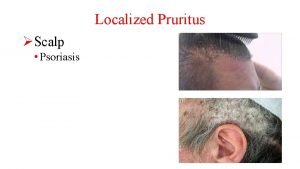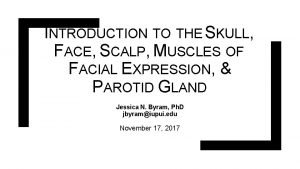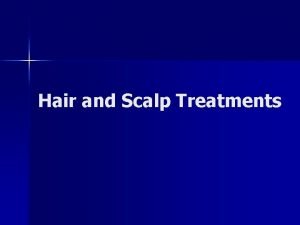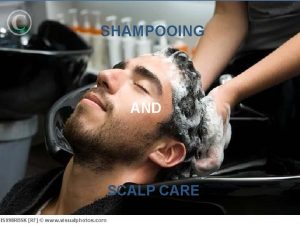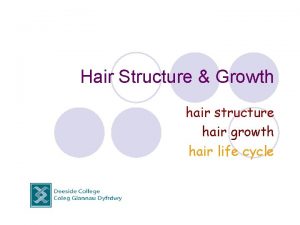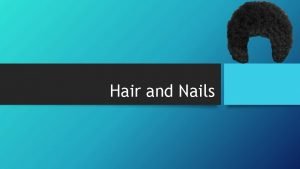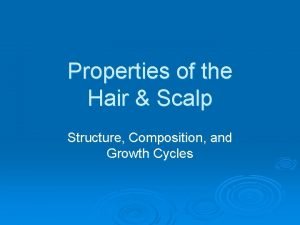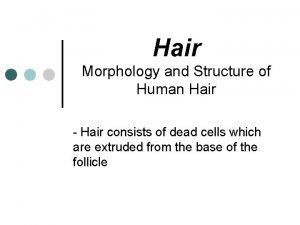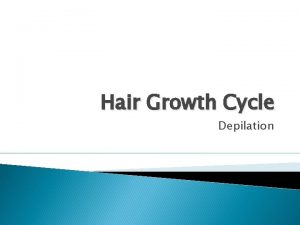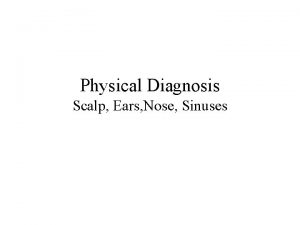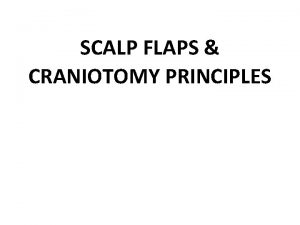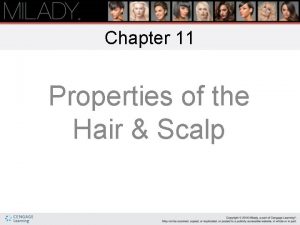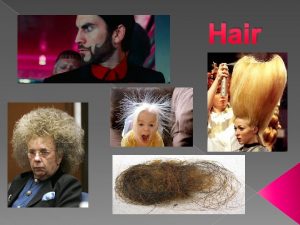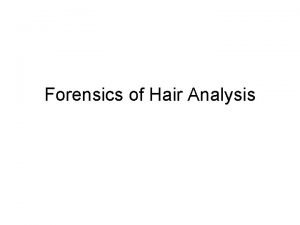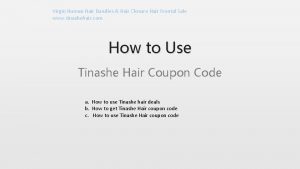Properties of the Hair and Scalp The structure






























- Slides: 30

Properties of the Hair and Scalp

The structure of the hair. . . The Epidermis is the first layer of the skin The hair follicle houses the hair Sebaceous glands secrete sebum this keeps Hair and skin from drying out Your arrector pili muscles give you goose bumps

Stuctures continued. . The hair bulb is thickened and a club liked structure it fits over the Dermal Papilla. It is like the mother of the hair as it feeds the hair. Did you know you have hair all over your whole body except the ______ and ____________? (google it, if you do not know)

Hair is made up of Amino Acids… Hair is composed of 90% protein. Living cells begin their journey upward through the hair follicle. They mature in a process called keratinization. As the cells move up the follicle they fill up with a fibrous protein called keratin. By the time they emerge to the scalp, they have lost their nucleus and are no longer living. Protein is made up of a long chain of amino acids which then turn into elements… SO COOL RIGHT?

The elements that make up hair. . . These elements are: (whew no wonder hair stinks when it is burned) Carbon - 51% Oxygen - 21% Nitrogen - 17% Hydrogen - 6% Sulfur - 5%

Understanding hair structure So then these proteins that are made up of long chains of amino acids are joined end to end like pop beads. The pop beads are joined by a peptide bond also known as an end bond this is now called a polypeptide chain. They intertwine in a spiral shape called a helix. Then all these polypeptide chains are linked like rungs of a ladder across from each other by side bonds. Confusing right?

The story of bonds. . . So bonds are important to hairdressers, there are three! First we have weak physical hydrogen bond, these bonds are broken by heat and water. We use these in styling hair. There are lots of these bonds. Secondly we have another weak physical bond called a salt bond. This is broken by changes in p. H. We will come to p. H later in more depth but alkaline or acidic solutions can break these bonds. Again pretty abundant in the hair. Lastly we have a disulfide bond. It is a strong chemical bond that is broken by chemicals such as a perm solution. There are less disulfide bonds in your hair but they are stronger so still make up ⅓ of the strength of your hair.

Potential Hydrogen p. H is important to hairdressers because of salt bonds and solutions too high in alkaline or too low in acidic can damage the hair. An ion is an atom or molecule that carries an electric charge. A positive charge is a cation and anion is a negative charge. A p. H measures the ions. Fun fact only products that contain water can have a p. H Pure water has a neutral p. H (it contains the same number of anions and cations). Blood is slightly alkaline with a 7. 35 or 7. 45 p. H measurement. Hair and skin are around 4. 5 to 5. 5 on the p. H scale.

The scale Hair is 4. 5 to 5. 5 *Hair lightener is 8. 5 to 10. 5 when mixed with developer which is acidic 4. 5 to 5. 5. What do you think it is before it is mixed? Too alkaline for your hair, that is for sure.

Hair pigment Melanin are tiny grains of pigment in the cortex to give hair it’s natural colour. There are two types of melanin: Eumelanin provides dark brown to black colour to hair Pheomelanin which provides natural colour ranging from red, ginger, yellow to blonde tones All natural hair colours have both eumelanin and pheomelanin except for albinos.

Wave patterns are result of genetics! There are two theories: One that the cross section of the hair determines your curl pattern. It is true that cross sections of straight hair tend to be round and curly hair tends to be more oval but modern microscopes have shown that cross sections of hair can be almost any shape Another theory suggests one side grows faster than the other causing it to curl but this theory has yet to be proven.

Hair Growth Vellus hair also known lanugo hair is short, fine, non pigmented and downy hair that appears on the body. Women have 55% more vellus hair than men and it helps to absorb perspiration Terminal hair is long, coarse, pigmented hair found commonly on your head, arms, and legs. All hair follicles are capable of growing both vellus and terminal hair depending on hormones , genetics and age.

The cuticle is the outermost layer of the hair. It consists of a single overlapping layer of transparent scale like cells that look like shingles on a roof. The cuticle protects your hair and can give it the appearance of shiny and smooth hair when closed as well as it can feel like silk. To make changes in the cortex to either perm or colour the hair a stylist must use an alkaline product to swell the cuticle and allow to expose the cortex

The cortex… The meat and potatoes of the hair The cortex layer of the hair makes up 90% of the weight of the hair. It houses all your polypeptide chains, bonds and melanin. This is where serious change happens in the hair.

The medulla A bit of a mystery is the medulla… There is no known function and it does not come into play for salon services but fun facts about the medulla are: Blondes and people with fine hair commonly don’t have a medulla Male beards have a medulla Animals have a medulla and its ratio is larger than found on human hair.

The three phases of hair growth Anagen also known as the growth phase. Your hair is in this phase for 90% of its life. This phase can last up to 10 years but commonly lasts between three and five years. Hair grows 1. 25 cms in one month. Do the math… How long could you hair be if it had a three year life span and how long would it be if you had a six year life span excluding the catagen or telogen phase? Catagen is a brief stage also a transition phase, the follicle canal shrinks and detaches from the dermal papilla. This phase last one to two weeks The telogen phase also known as the resting phase. It is the final stage. The last 3 to 6 months. As this phase ends the anagen begins again. . .

Other growth patterns Cowlicks- Hair growing up away from the scalp Stream- Hair growing down (this is the one you want) Whorls- Hair growing in a circular direction What growth patterns do you have?

Abnormal hair loss- Alopecia Androgenic alopecia- male pattern baldness. Terminal hair turns into vellus hair. This is a result of genetics, age and hormonal changes. This can happen to women as well. Alopecia areata - Hair loss from an autoimmune disorder. White blood cells stop hair growth during the anagen phase. This can happen in small patches or all over your whole body. (Alopecia totalis) Postpartum alopecia is a temporary hair loss experience after having a baby

Treatment of alopecia This is a good opportunity for you to research. Check your sources! How do you treat each of the different types of alopecia? *Androgenic *Postpartum *Areata

Disorders of the Hair Find the term for the following definitions or conditions: 1. A variety of of canities, characterized by alternating band of gray and pigmented hair. 2. A condition also known as hirsuties, growth of terminal hair where vellus hair is usually found 3. Technical term for split ends 4. Technical term for brittle hair

Disorders of the scalp The biggest one is a result of a fungus called malassezia…called Pityriasis Dandruff is caused by this fungus but also by the shedding of dead skin cells Stress, hormones, age, and poor hygiene can affect this condition Research the definitions of both types of dandruff and how you can treat both types “Pityriasis capitis and pityriasis steatoides”

Fungal Infections Tinea is the technical term for ringworm. It is characterized by itching, scales and sometimes painful circular lesions. Pediculosis capitis is the technical term for head lice.

Parasitic Infections Scabies is a highly contagious skin disease that is caused by a parasite called a mite. It burrows under the skin. Blisters and inflamed like pimples with pus form on the scalp. It is itchy!

Staphylococcus infections Lastly we have bacterial infections, there are two common staph infections they are a furuncle (a boil) and a carbuncle a larger boil. We have to be very diligent to avoid the spread of fungal, bacterial and parasitic infections by taking the proper cleaning, sanitation and disinfecting measures in the salon/classroom. Do not treat anyone with these infections!

Analysis of the hair ● ● Texture Density Elasticity Porosity It is important for a hairdresser to know how to analyze the hair for these properties, it can affect the success of our services.

Texture is determining the diameter of each individual hair shaft. To determine whether your client has fine, average or coarse hair, you take one individual hair at the crown (this is used as it usually represents the average hair on the head) and roll it between your fingers. It is hard with limited experience to know when you roll an individual hair whether you are feeling fine, average or coarse but usually fine hair you can not feel or barely feel but coarse hair is quite noticeable. Is your hair fine, average or coarse?

Porosity is the ability for hair to absorb moisture and retain it. You can analyze whether your client has resistant hair ( a tight cuticle) porous hair (slightly raised cuticle) or highly porous hair that looks like the cuticle is blow out (rough and fuzzy looking). Another test you can do is to cut a piece of hair off your client or yourself and put it in some water. If it floats it has good porosity. If it sinks to the bottom it is highly porous. Is your hair resistant, slightly porous, porous or overly porous? Remember porosity may be different on various parts of your head.

Elasticity This is the ability for your hair to stretch and then return to its original shape. As we lose our elasticity, hair will break. This is when your side bonds have become weaken or broken. Hair will stretch up to 50% more when wet then dry so if combing out your hair when it is wet is difficult you may have poor elasticity. Does your hair have good elasticity called normal or low elasticity where it breaks?

Density is the amount of hairs per square centimetre on your head. I think of it as the population. My hair is more like Sebringville or maybe Mitchell but others with lots of hair are more like Toronto. Sometimes coarse hair tricks you into thinking that you have high density. Something to keep in mind is Blondes (140, 000 per 2. 5 cm squared) have the highest density and red heads have the least (80, 000 per 2. 5 cm squared) You may think my friend is a redhead and she has super thick hair. She probably has coarse hair… Do you have high, average or low density?

Do the analysis of your hair Here is a video to help you with the analysis https: //www. youtube. com/watch? v=_J 5 XUZ 9 t. Ag 4
 Chapter 11 properties of the hair and scalp answers
Chapter 11 properties of the hair and scalp answers Properties of the hair and scalp
Properties of the hair and scalp Tuft of hair that stands straight up
Tuft of hair that stands straight up Disulfide bonds in hair
Disulfide bonds in hair Cossh stand for
Cossh stand for Chemistry of shampoo
Chemistry of shampoo Dark hair and blonde hair parents
Dark hair and blonde hair parents Tacheometric distance equation
Tacheometric distance equation Dermal papilla
Dermal papilla Canities
Canities When does the rebel keep his hair long
When does the rebel keep his hair long Hair grows in diagonal tubes called hair
Hair grows in diagonal tubes called hair Scale pattern of human hair
Scale pattern of human hair Hh
Hh Extensive vs intensive
Extensive vs intensive Chemical and physical properties
Chemical and physical properties What are the two basic requirements for a healthy scalp
What are the two basic requirements for a healthy scalp Zygomaticus minor muscle
Zygomaticus minor muscle Gacha club
Gacha club Draws corners of the lip back (laterally)
Draws corners of the lip back (laterally) A hair’s form and structure is known as what?
A hair’s form and structure is known as what? Arrector pili muscle
Arrector pili muscle Galea aponeurotica
Galea aponeurotica Norma superior
Norma superior Diploic veins
Diploic veins Dangerous area of scalp is which layer
Dangerous area of scalp is which layer Danger area of the scalp
Danger area of the scalp Scalp iv
Scalp iv Buccal branch of facial nerve
Buccal branch of facial nerve Crater
Crater Ethmoid bone and lacrimal bone
Ethmoid bone and lacrimal bone
